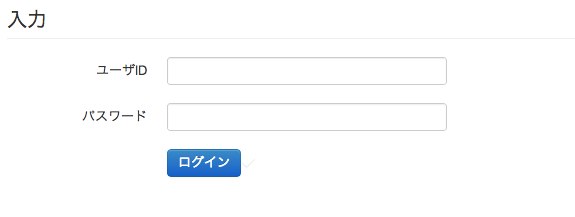SAStrutsでは、入力チェックをFormのアノテーションや、メソッドを定義することで実行することができます。
特にFormのアノテーションによるチェックは、表示するエラーメッセージの処理を独自で書く必要がなく、フレームワークで請け負ってくれるため非常に便利です。
しかし、エラーメッセージの表示には画面の再描画(画面遷移)が必要となるため、Ajaxによる非同期通信ではこの恩恵を受けることができません。
そこで、AjaxリクエストでもFormのアノテーションによる入力チェックと、エラーメッセージの表示を行う方法を紹介します。
入力画面
まずは、入力画面の抜粋です。入力項目に「ユーザID」と「パスワード」を準備しました。「ログイン」ボタンは、Ajaxで処理するため[type="button"]としています。対応するFormクラスでは、「ユーザID」と「パスワード」の両方に[@Required]を設定します。
<!-- Ajax処理のエラーメッセージ表示域 --> <div id="ajaxErrorMessage"></div> <!-- Ajax処理のリクエストパラメータ --> <s:form styleId="form" styleClass="form-horizontal"> <legend>入力</legend> <div class="control-group"> <label class="control-label">ユーザID</label> <div class="controls"> <html:text property="userId" styleId="userId" styleClass="input-xlarge" maxlength="10"/> </div> </div> <div class="control-group"> <label class="control-label">パスワード</label> <div class="controls"> <html:password property="passwd" styleId="passwd" styleClass="input-xlarge" maxlength="15"/> </div> </div> <div class="control-group"> <div class="controls"> <input type="button" class="btn btn-primary" id="login" name="login" value="ログイン"/><i class="icon-ok icon-white"></i> </div> </div> </s:form>
Actionクラス
Actionクラスでは、Ajaxを受け付けるloginメソッドと、入力エラー時処理を行うajaxErrorメソッドを準備しました。Executeアノテーションのvalidate属性に[@]とし、Formクラスのアノテーションによる入力チェックを実行します。
@Execute(validator=true, validate="@", input="ajaxError") public String login(){ /* ログイン処理 */ /* レスポンスに対する処理 */ return null; } @Execute(validator=false) public String ajaxError(){ /* リクエストからメッセージオブジェクトを取出す。 */ HttpServletRequest request = RequestUtil.getRequest(); ActionMessages messages = (ActionMessages)request.getAttribute(Globals.ERROR_KEY); if(messages==null) return null; /* application(_ja).propertiesの定義を利用してメッセージを生成する。 */ List<String> messageList = new ArrayList<String>(); for(Iterator<?> iter = messages.get(); iter.hasNext();){ ActionMessage msg = (ActionMessage)iter.next(); messageList.add(MessageResourcesUtil.getMessage(msg.getKey(), msg.getValues())); } /* メッセージをjson形式に変換して、レスポンスを返す。 ここで設定している[status]は、JavaScript側でエラーの有無を判断するのに利用する属性です。 */ Map<String, Object> map = new HashMap<String, Object>(); map.put("status", false); map.put("messages", messageList); String json = JSON.encode(map); ResponseUtil.write(json); return null; }
JavaScript
入力エラーの場合に、json形式で返されたメッセージを整形して表示する処理を定義しています。あと、serializeArray()はForm要素内の入力値をjson形式で返します。便利なのでオススメです。
<script> //ログインボタン イベントのバインド $(document).ready(function(){ $('#login').bind('click', function(event){ validator(); }); }); //ログインボタン押下処理 function validator(){ $.ajax({ type:'get', dataType:'json', url:'${f:url("/login")}', cache:false, data:$('#form').serializeArray(), success:function(json){ if(json.status==false){ //エラーが発生した場合、エラーメッセージを表示する要素を組立てる。 var elem = '<div class="alert alert-error"><ul>'; for(i in json.messages){ elem += '<li>'+json.messages[i]+'</li>'; } elem += '</ul></div>'; //Ajax処理のエラーメッセージ表示域に、エラーメッセージを挿入する。 $('#ajaxErrorMessage').html(elem); return; } //正常時処理 }, error:function(jqXHR, textStatus, errorThrown){ //異常時処理 } }); } </script>











